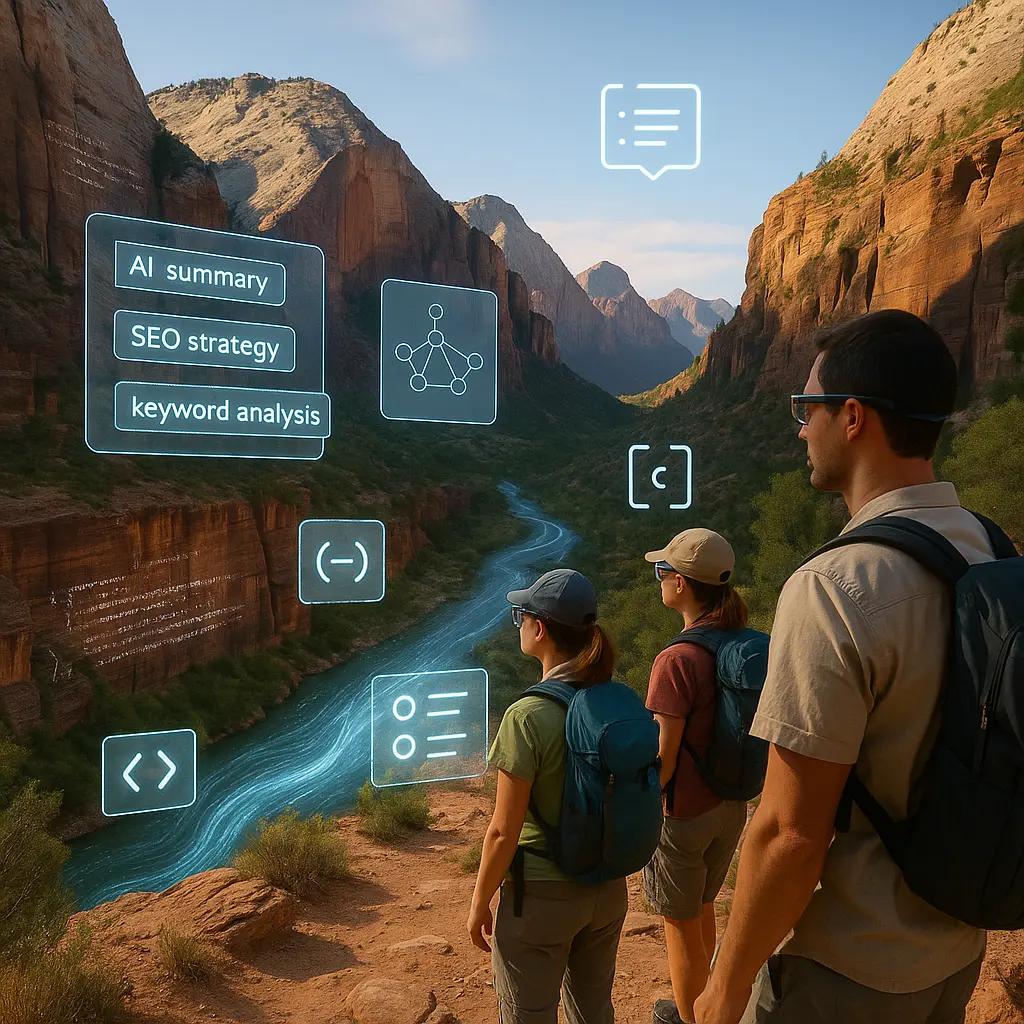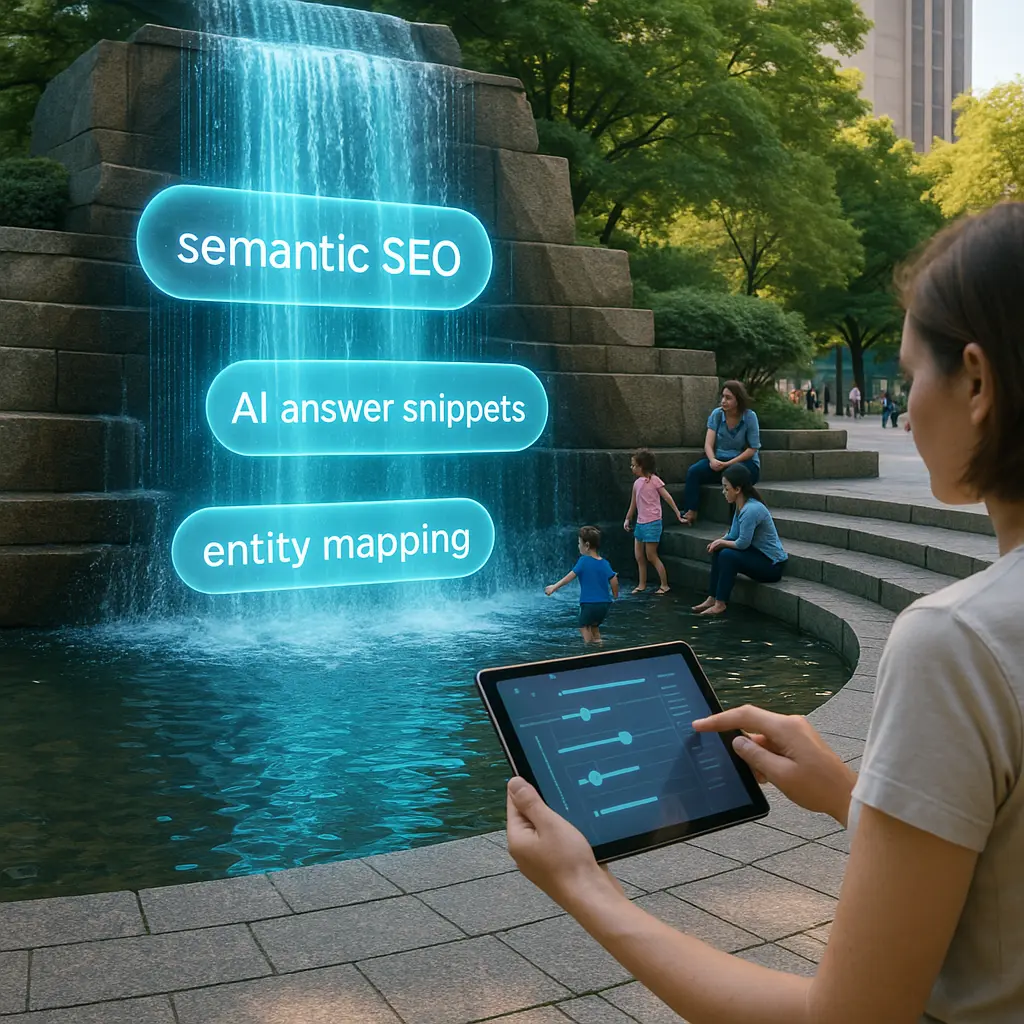Table of Contents
ai search optimization
Key Takeaways
- AI Search Optimization extends classic SEO with semantic and entity signals. It leverages Generative Engine Optimization and Large Language Model Optimization (LLMO) to earn AI Answer Citations, blending natural language processing SEO with AI-specific metadata and structured content cues.
- Robust technical foundations unlock AI-driven Visibility. Prioritize Core Web Vitals (LCP < 2.5 s, INP < 200 ms, CLS < 0.1) and mobile-first design to ensure fast AI ingestion. Implement clean JSON‑LD, and FAQ schema parsing to guide AI crawlers.
- Trust signals – E‑E‑A‑T and brand citations – drive AI citation performance. Showcase Experience via case studies, Expertise with verified bios, Authoritativeness through earned media, and Trustworthiness with secure policies. These AI-powered Search Ranking signals convince LLMs to cite your content.
- Continuous monitoring and advanced tactics sustain AI SEO success. Track AI citation frequency, share of voice, and AI answer rank using AI visibility tools like SE Ranking AIO Tracker and Otterly.AI. Layer in Answer Engine Optimization (AEO) alongside GEO, plus iterative content updates, to stay ahead of generative AI responses.
Introduction to AI Search Optimization
“AI selects answers. AI shapes markets.” That bold shift is no longer coming – it’s here.
AI Search Optimization (also known as Generative Engine Optimization or Large Language Model Optimization, LLMO) is the practice of enhancing your content and technical signals so AI‑powered search engines and chatbots can find, understand, and feature your brand. In 2025, zero-click searches rising to more than 40% of all queries. If your pages aren’t optimized for AI summary citation, you risk invisibility in the very place your customers are looking.
Traditional SEO focused on keywords and backlinks. Today, your SEO strategy must include:
- Semantic analysis via natural language processing SEO to ensure meaning is crystal clear.
- In-depth content (semantic depth) so AI treats your page as a one-stop resource for AI Overviews Optimization.
- Entity recognition SEO to make “YourBrand” an unmistakable entity in AI’s knowledge graph.
- Structured content cues (FAQ schema parsing, HowTo markup) that power AI Content Discoverability.
Are you not sure where to begin? This guide covers:
- Evolution of AI-Driven Search Engines: How we moved from keywords to generative AI.
- Why Brands Need AI Search Optimization: The business case backed by data.
- Core Principles of AI Search Optimization: Semantic understanding, content depth, entity focus, schema tactics.
- Technical Foundations for AI SEO: Page Experience, mobile-first design, JSON‑LD, llms.txt signals.
- Trust & Authority (E‑E‑A‑T) for AI: Building credibility so AI cites your brand.
- Monitoring AI Visibility: New KPIs – AI answer inclusion rates and AI-driven referral traffic.
- Advanced Strategies & Case Studies: Real-world examples of AI SEO success.
- Next Steps: A roadmap to start optimizing for AI Search in 2025.
By the end, you’ll have a clear plan to boost AI‑driven visibility, secure AI answer citations, and stay competitive as AI-powered Search Ranking reshapes digital discoverability.
Evolution of AI-Driven Search Engines
Search began with keyword matching and link signals. In 2012, Google’s Knowledge Graph introduced entities into SEO. By 2015, RankBrain used neural search optimization for intent understandingsemrush.com. Featured snippets and voice answers soon followed, giving users direct answers without clicking.
Key milestones in AI-driven search:
- 2012: Knowledge Graph – entities enter the fray.
- 2015: RankBrain – machine learning for query interpretation.
- 2022: ChatGPT launch – LLMs demonstrate conversational Q&Aseo.com.
- 2023: Bing + GPT‑4 integration – generative AI in mainstream searcharxiv.org.
- 2024: Google SGE – AI Overviews Optimization in 47 % of SERPsssemrush.com.
Simultaneously, new AI search platforms emerged. ChatGPT became a de facto search tool; Perplexity.ai offered generative answers with citations; even DuckDuckGo and You.com rolled out AI assistants. User habits shifted: 58 % of consumers now seek product recommendations from AI tools.
Today, a search for “best CRM tools” often returns an AI summary that cites multiple sources. If your brand isn’t among them, you lose mindshare – and potential customers – before they ever see your site.
Why Brands Need AI Search Optimization
Visibility Impact: AI Overviews appear in 47 % of Google searches. Without AI optimization, brands vanish from this new front-page real estate.
Consumer Behavior: 58 % of buyers use AI for recommendations – up from 25 % last year. During the 2024 holiday season, AI referrals to retailers surged 1,300%, proving AI can drive both visibility and sales.
Competitive Edge: Early adopters of AI SEO are already capturing prime AI answer space. One case study showed a site boost AI referral traffic by 25% MoM after implementing AI Overviews Optimization best practices.
Brand Control: When AI synthesizes answers – “According to Brand X…” – it cements your authority. If your content isn’t formatted for AI content semantics and entity recognition SEO, you cede narrative control to competitors or generic sources.
E‑E‑A‑T for AI: AI models favor high‑trust sources. Brands with clear expertise, author credentials (Person schema), and organizational signals (Organization schema) gain AI answer citation more often.
Ignoring AI Search Optimization is not an option. By aligning your brand with AI’s new signals – semantic analysis, in-depth coverage, structured content cues, and strong entity profiles – you secure visibility in both traditional SERPs and AI-powered Search Ranking.

Ignoring AI Search Optimization is not an option.
Contact us today!Core Principles of AI Search Optimization
AI Search Optimization demands a fresh approach. Four pillars guide the way:
- Contextual Understanding & Semantic Analysis
- In‑Depth Content for AI Overviews Optimization
- Entity Optimization for LLMO
- Structured Content & Schema Markup for AI Content Discoverability
Each principle overlaps with traditional SEO but raises the bar for AI‑powered Search Ranking. Think of it as “help the AI help you” by delivering meaning, depth, clear entities, and machine‑readable structure.
Contextual Understanding and Semantic Analysis
AI doesn’t just match keywords. It reads for meaning. When a model processes your page, it maps concepts, synonyms, and related terms – building a web of understanding far beyond exact phrases.
Why context matters:
- AI models use natural language processing SEO to parse full sentences, not fragments.
- The 2019 BERT update taught Google to grasp intent; today’s LLMs take it further by weighing semantic depth across your entire page.
Key tactics for semantic SEO:
- Contextual term enrichment: Sprinkle related concepts and LSI keywords (e.g., “AI‑driven search results,” “ChatGPT optimization,” “neural search optimization”) to broaden your topic’s scope.
- Topical breadth: Answer the who, what, when, where, why, and how of your subject. If you explain “how to optimize for AI search engines in 2025,” dive into methods, tools, metrics, and case examples.
- Entity clarity: Distinguish “Jaguar cars” from “jaguar the animal.” Use consistent names and brief parentheticals to disambiguate.
- Intent matching: Match content format to likely query intent. A “why” question deserves analysis; a “how” question demands steps.
Example checklist:
- Turn subheads into questions that mirror user queries.
- Include definitions, examples, and mini‑case studies.
- Use bold or italics on first mentions of key entities to flag importance.
By writing with context and meaning, you craft pages that an AI model confidently selects as comprehensive answers.
In‑Depth Content for AI Overviews Optimization
Surface‑level blurbs won’t make the cut. AI Overviews Optimization thrives on comprehensive, tightly focused guides that leave no question unanswered.
Why depth wins:
- Overviews pull from multiple sources; if your page covers 80 % of the answer, the AI will lean on you heavily.
- Informational queries trigger AI summaries nearly 90 % of the time – a Semrush study found – so depth directly correlates with AI summary citation.
What in-depth looks like:
- Complete coverage: Definitions, benefits, challenges, examples, steps, and FAQs all in one place.
- Logical sections: Clear H2s like “Benefits of AI Search Optimization,” “Step‑by‑Step Implementation,” and “Common Pitfalls.”
- Bullet lists & tables: AI often lifts lists verbatim – use them for pros / cons, feature comparisons, or data points.
Sample structure for an “Optimizing for AI Search Engines” guide:
- Introduction & Key Benefits
- How Generative Engine Optimization Works
- Core Techniques (Semantic Analysis, Schema, E‑E‑A‑T)
- Step‑by‑Step Action Plan
- Case Study Snapshot
- FAQ Section
Chunking long‑form content into digestible modules ensures both users and AI find exactly what they need.
Entity Optimization for Large Language Model Optimization (LLMO)
At its heart, LLMO is entity recognition SEO on steroids. You want AI models to see your brand, products, and experts as authoritative nodes in their knowledge graph.
Defining entity optimization:
- Schema markup: Use Organization and Person schema to label your company and authors.
- Consistent naming: Always call your flagship product “Acme AI Optimizer,” never “A.A.I.O.” or “Acme Optimizer.”
- Public authority: Secure Wikipedia or Wikidata entries when eligible – many AI models rely on those sources for entity facts.
Content strategies:
- Publish detailed “About” pages for each entity (product, service, key executive).
- Link out to authoritative mentions – guest posts, press features, and interviews – to reinforce your entity’s network.
- Test AI assistants directly: ask ChatGPT or Bard about your brand. If the answer omits you, refine your entity signals.
By cultivating clear, well‑linked entities, you ensure AI Answer Citation leans toward your site when generating generative AI responses.
Structured Content & Schema Markup for AI Content Discoverability
Just as a well‑organized library helps readers locate books in seconds, structured data guides AI to the exact facts it needs. By labeling key elements on your pages, you make it easier for generative models to lift quotes, steps, and specifications straight into their answers.
Key Schema Types
| Schema Type | Purpose for AI‑Driven SEO |
| FAQPage | Supplies question‑and‑answer pairs that AI can quote directly |
| HowTo | Outlines step‑by‑step instructions that generative responses can enumerate |
| Article | Highlights author, date, and publisher details to reinforce credibility |
| Product | Delivers specs, reviews, and ratings for AI‑powered shopping advice |
| Organization | Defines your brand’s identity – name, logo, social profiles – to cement its authority |
While an llms.txt file has been proposed as a “sitemap for AI,” no major AI provider currently honors it, and there’s no solid evidence it boosts citations or rankings. Treat llms.txt as a low‑cost experiment if you like, but focus first on proven schema markups that deliver immediate value.
HTML Formatting Tips
- Use semantic headings (<h1>, <h2>, <h3>) to map out your content’s hierarchy.
- Encode lists with <ul>/<ol> tags so AI reliably recognizes each item.
- Present comparisons in proper <table> elements rather than buried in paragraphs.
- Include an FAQ section at the bottom of long pages – plain Q&A blocks are a magnet for AI answers.
Implementing schema often pays off today with rich snippets – and it lays the groundwork for tomorrow’s AI‑powered search features. Run your pages through Google’s Rich Results Test or Bing’s Markup Validator to catch any errors, then empower your team to roll out fixes swiftly.
By mastering these four principles – semantic analysis, content depth, entity focus, and structured markup – you align your strategy with AI’s needs. You’ll speak the AI’s language, stand out in AI Overviews Optimization, secure AI Answer Citations, and ultimately claim prime real estate in AI-driven search results.

Lead with clarity – equip your content and tech stack to match how AI selects trusted sources.
Start today!Technical Foundations for AI SEO
“40% of users abandon a site that takes more than 3 seconds to load.” Fast pages keep readers – and AI bots – happy.
Optimizing for AI-driven search means more than crafting perfect prose. You must also ensure your website loads swiftly, adapts to every device, and speaks a clear, structured data language. These technical pillars – Page Experience, Mobile‑First Design, and AI‑focused metadata – form the backbone of AI Search Optimization.
We’ll explore:
- Page Experience & Core Web Vitals
- Mobile‑First Design and Fast Load Times
- Clean JSON‑LD, llms.txt Signals & AI‑Specific Metadata
Each element reinforces the others. A rapid, mobile‑friendly site that exposes well‑formed schema ensures your rich, semantically optimized content can be discovered, crawled, and cited by AI systems.
Page Experience, Core Web Vitals & AI‑Driven Visibility
A page that loads fast, responds instantly, and remains visually stable isn’t just user‑friendly – it’s AI‑friendly. Google’s Core Web Vitals (Largest Contentful Paint, First Input Delay, Cumulative Layout Shift) remain ranking signals. Content that ranks well in traditional search feeds AI overviews and generative answers.
- LCP under 2.5 s ensures your main content appears quickly.
- FID under 100 ms lets readers – and bots – interact without hiccups.
- CLS under 0.1 prevents jarring layout shifts that confuse parsers.
When AI snippets link to your guide, a smooth experience keeps visitors engaged. A quick fetch by AI crawlers reduces timeout risks, boosting the chance your content will be fully “read” and cited.
Mobile‑First Design and Fast Load Times
Google indexes your mobile site first – and many AI interactions simulate mobile requests. If your mobile pages falter, both search and AI may overlook your content.
- Responsive Layouts: Ensure text, images, and buttons adapt to any screen.
- Optimized Resources: Compress images, defer non‑essential scripts, and serve modern formats (WebP).
- Concise Content Blocks: Short paragraphs and bullet lists load faster and map neatly into voice‑AI answers.
Voice assistants and chatbots often draw from mobile‑optimized snippets. A seamless mobile experience is a quality signal that AI uses – much like human satisfaction metrics in traditional SEO.
Clean JSON‑LD, llms.txt Signals & AI‑Specific Metadata
Structured metadata guides AI to the facts you want cited.
- JSON‑LD Schema
- Validate with Google’s Rich Results Test.
- Include FAQPage, HowTo, Article, Product, Organization as discussed.
- Meta Controls
- Use <meta name=”robots” content=”nosnippet”> sparingly to shape excerpts.
- Maintain accurate <title> and <meta description> – AI may reuse them in citations.
- llms.txt Signals (Experimental)
- Place a simple text file at your site root listing priority URLs.
- No major AI provider enforces it yet, but it’s a lightweight experiment that won’t harm existing SEO.
- Crawlability Checks
- Keep XML sitemaps updated.
- Ensure robots.txt doesn’t block emerging AI crawlers.
Even if llms.txt remains unclaimed technology, clean, validated schema and accessible pages ensure AI systems can fetch and trust your structured content.
Quick Technical Checklist
- ✔️ Core Web Vitals: LCP < 2.5 s, FID < 100 ms, CLS < 0.1
- ✔️ Mobile‑Friendly: Responsive design, readable text, clickable elements
- ✔️ JSON‑LD Valid: No errors in Rich Results Test
- ✔️ Meta Tags: Clear titles, descriptions, selective nosnippet use
- ✔️ Crawl Access: Up‑to‑date sitemap; no blocks for key bots
By treating your site as both a library for readers and a data feed for AI, you guarantee that every investment in content quality pays off. Fast, mobile‑optimized pages with crystal‑clear metadata become the sources AI bots prefer to cite – and users prefer to explore.

Accelerate your infrastructure now to meet AI’s performance expectations – and get cited first.
Book a call now!Building Trust with E‑E‑A‑T & Brand Citations
“Trust defines authority.”
AI systems scan the web for signals of reliability before choosing what to quote. Without clear markers of experience, expertise, authoritativeness, and trustworthiness, your content may never make the cut. Here’s how to make AI see you as the go‑to source.
Experience, Expertise, Authoritativeness, Trustworthiness (E‑E‑A‑T)
AI SEO thrives on credibility. You can craft perfect prose, but without trust signals, generative models skip you.
- Experience
- Showcase firsthand knowledge. Describe real projects, case studies, or anecdotes that only you could share.
- Example: “In our 2023 pilot of AI‑driven visibility tools, we increased citation rates by 45%.”
- Expertise
- Feature clear author credentials. A byline like “Jane Doe, PhD in NLP, 10 years in AI Search Optimization” sends a loud signal.
- Use Author schema (Person) in your JSON‑LD to tie that byline directly to technical metadata.
- Authoritativeness
- Cite reputable sources and include outbound links to peer‑reviewed studies or industry reports.
- Add Organization schema (Organization) that lists your headquarters, social profiles, and awards.
- Trustworthiness
- Use HTTPS, display your privacy policy, and fact‑check every statistic.
- Keep content up to date: mention the date of last update in your Article schema (dateModified).
Mini‑Checklist:
- Author bio with credentials
- Case studies or first‑party data
- Outbound citations to authority sources
- Validated JSON‑LD for Person & Organization
By embedding these elements, you make it easy for AI models to recognize your content as a reliable citation.
Securing Earned Media Mentions for AI Answer Citation
AI models learn from – and often quote – high‑authority publications. Earning mentions in respected outlets multiplies your trust footprint:
- Digital PR Outreach
- Pitch insights or data to industry blogs, trade journals, and mainstream media.
- Target publications known to feed AI training data (e.g., TechCrunch, Forbes, Wired).
- Guest Contributions
- Write expert op‑eds or how‑to guides that include links back to your own site.
- Each link acts as an AI signal that your brand is a recognized source.
- Research Collaborations
- Partner with universities or institutes on whitepapers.
- When your study appears on .edu or .org domains, AI models are more likely to trust you.
- Industry Awards & Conferences
- Publish post‑conference recaps on your blog and in partner media.
- Use Review schema or Event schema to mark up awards or speaking engagements.
Table: Brand Citation Sources
| Source Type | Example Domains | Data Type |
| News Outlets | forbes.com, nytimes.com | Quotes, interviews |
| Industry Blogs | searchengineland.com | How‑to articles |
| Academic Publications | .edu, .org journals | Research papers |
| Conferences & Awards | event pages, award lists | Event schema, Review schema |
When AI composes an answer, it often layers insights from multiple sources. The more your brand appears across that mix, the higher your chance of being directly cited.
Driving AI Answer Inclusion Rates
Are you not sure why competitors keep appearing in AI responses? They’ve aligned content structure with E‑E‑A‑T and piled up brand mentions. You can replicate that:
- Answer Popular Questions
- Identify high‑volume queries (“steps to get cited in AI chatbot answers”) and craft concise, structured answers.
- Use FAQPage schema so AI can lift Q&A pairs with precise citations.
- Map Content to AI Patterns
- Review generative AI responses in your niche. Note which paragraphs or bullet lists get echoed.
- Mirror that structure, then enrich it with your own case studies and expert quotes.
- Monitor and Adapt
- Test queries in ChatGPT or Bing Chat. Check which sources appear and why.
- If your brand is missing, audit gaps: perhaps you lack a key statistic or a clear expert byline.
- Leverage Structured Content Cues
- Use numbered steps and bold headers. AI systems often reproduce these as-is.
- Embed AI‑specific metadata like citation properties in JSON‑LD (where supported) to label fact sections.
By systematically aligning on‑site trust signals with off‑site brand footprints, you boost your AI answer inclusion rate – and become the trusted voice AI platforms cite first.
Establishing E‑E‑A‑T and securing brand citations isn’t a quick hack; it’s a strategic commitment to quality and credibility. Yet, each expert byline you publish and each reputable mention you earn both translate directly into AI‑powered search ranking and AI Answer Citation. The reward? Your brand becomes the authority that AI relies on – and that readers trust.

Boost your E-E-A-T signals and earn the AI citations that position you as a market leader.
Contact us today!Monitoring and Measuring AI Visibility
“You can’t improve what you don’t measure.”
When AI models serve answers without clicks, traditional SEO metrics fall short. You need fresh indicators – citations, AI‐driven referrals, overview impressions – to know if your AI Search Optimization is working.
Why Measure AI Visibility Differently
AI answers often satisfy users without sending them to your site. That zero‐click outcome feels rewarding yet invisible in Google Search Console. To gauge real impact, track:
- AI Citations (how often an AI names or links your content)
- AI‑driven Traffic (referrals from Bing Chat, ChatGPT browsing, etc.)
- AI Overview Impressions (appearances in Google’s AI overviews)
Without these metrics, you’re blind. By expanding your KPI set, you’ll see the full picture of AI‐powered reach.
AI Visibility Tools and Metrics
Several SEO platforms are rolling out AI‐specific dashboards. Look for features like:
- AI Overview Reports showing keywords where you appear in SGE
- Citation Counts indicating how many times your domain is listed as a source
- Perplexity Source Rankings tracking mentions in generative responses
For example, Ahrefs may soon flag “AI-driven search results” where your content surfaces. Keep an eye on vendor roadmaps – and on announcements from Google or Bing about new reporting capabilities.
Analytics and Referral Tracking
Standard analytics hide some AI visits under “(not set)” or unusual referrers. To uncover AI traffic:
- Filter Referrals
- Bing Chat traffic often shows as bing.com or edgeservices.net.
- ChatGPT plugin clicks may appear as direct or “(not set)”. - Segment by User‑Agent
- Look for patterns like “ChatGPT” or “OpenAI” in user‑agent strings.
- Analyze Engagement
- Google reports that AI‐referred visitors spend more time on page.
Set up custom segments in GA4 or your analytics suite to isolate these visitors and track their behavior – time on site, pages per session, conversions.
Tracking AI Answer Citations & AI Overviews Optimization
Tracking Citations Manually
Not every AI mention yields a click. Periodic manual checks help fill gaps:
- Query AI Assistants
- Ask ChatGPT or Bing Chat your key questions and note if your brand or URL is mentioned.
- Use Citation‑Friendly Providers
- Perplexity.ai lists sources per sentence – record when your site appears.
Keep a simple spreadsheet:
| Query | AI Platform | Date | Your Brand Cited? |
| how to optimize for AI SEO | Bing Chat | 2025‑06‑01 | Yes |
| best practices for AI Search | ChatGPT Browse | 2025‑06‑02 | No |
This log reveals trends and highlights content gaps quickly.
Adapting Strategy Based on Metrics
Data drives improvement. If AI citations rise after adding an FAQ schema, roll out similar schemas on other pages. If a competitor dominates certain queries in AI overviews, analyze their content structure and then create a richer, more authoritative version. Focus on:
- Trend Over Time: “We jumped from 5 to 20 AI citations this quarter.”
- Quality Signals: “AI‐driven traffic converts at 2× our average rate.”
Share these wins with your team. Use them to justify further investment in AI Search Optimization and to refine content strategy where visibility remains low.
By measuring AI visibility – through specialized tools, analytics tweaks, and manual checks – you gain actionable insights. You’ll know which tactics move the needle, where to focus next, and how to demonstrate ROI on your AI SEO efforts.

Track AI-specific KPIs now to future-proof your marketing strategy and validate ROI.
Contact us today!Advanced Strategies and Best Practices
“Optimizing for AI is an evolution of SEO, not a replacement.”
While classic SEO drives clicks from search results, AI Search Optimization aims to be the very answer users see. Let’s explore how Generative Engine Optimization (GEO) differs from traditional SEO, then arm you with cutting‑edge tactics – culminating in a deep dive on FAQ and HowTo schema.
Generative Engine Optimization (GEO) vs Traditional SEO
Generative Engine Optimization focuses on being included in AI‑generated responses. Traditional SEO targets ranking on a search engine results page (SERP) and maximizing click‑through rates. GEO shifts goals:
| Aspect | Traditional SEO | GEO (AI SEO) |
| Objective | Rank in top organic positions | Appear in AI answers and overviews |
| Content Strategy | Entice clicks with titles and snippets | Offer clear, citable sentences for AI lifts |
| Keyword Approach | Exact‐match keywords | Broad intent and related questions coverage |
| Success Metric | Impressions, clicks, rankings | Citations, AI impressions, zero‑click usage |
| User Behavior | User clicks, site visits | AI uses content even if user never clicks |
By comparing side‑by‑side, you see that GEO retains SEO fundamentals – quality content, technical health, E‑E‑A‑T – but adds emphasis on being the AI’s go‑to source.
Leveraging AI Search Engine Optimization Best Practices
Here are the advanced tactics to master GEO:
- Comprehensive Semantic Content
Cover main topics and subtopics deeply. Use related terms (contextual term enrichment) and entity mentions so AI understands scope and context. - Structured Data & Formats
Implement FAQ and HowTo schema, lists, tables, and clear headings. These “structured content cues” feed AI parsers and generative responses. - Technical Excellence
Maintain fast load times, mobile‑first pages, clean JSON‑LD, and accessible content (llms.txt signals optional). AI bots – like any crawler – reward healthy sites. - Robust E‑E‑A‑T Signals
Highlight author credentials, cite reputable sources, and secure earned media mentions. Trustworthy, expert content earns AI answer citations. - Continuous Monitoring & Adaptation
Track AI citations, AI‑driven referrals, and overview impressions. Refine content based on what AI selects in response to key queries.
These practices form your playbook. Cover them all, and you’ll excel at AI‑powered Search Ranking.
Leveraging AI Tools & Techniques
Why fight AI with human tactics alone? Use AI to sharpen your own strategy:
- NLP Analysis: Prompt models (e.g., “What questions does my article leave unanswered?”) to identify content gaps.
- AI‑Generated Drafts: Prototype headings or FAQs with ChatGPT, then refine for accuracy and tone.
- Competitive Scans: Ask AI assistants to list top sources on your topic – then compare their structure and depth to yours.
Brands that experiment with their own generative models often uncover hidden content opportunities, giving them an edge in generative AI responses.
FAQ & HowTo Schema for AI Parsing and Generative AI Responses
Structured Q&A and step lists are gold for generative engines:
- FAQPage Schema: AI can lift question‑answer pairs verbatim, crediting your site.
- HowTo Schema: AI enumerates your steps directly – perfect for “how do I…” queries.
- Implementation Tips:
- Place FAQs at the end of articles, addressing likely follow‑ups.
- Use clear, concise answers (1-2 sentences) for each question.
- Mark each step in HowTo schema with titles, images, and detailed instructions.
Sites that master these schema types often see their content quoted in Bing Chat and Google’s AI Overviews – a direct boost to AI Answer Citation.
Continuous Learning and Future‑Proofing
Generative AI will keep evolving. Stay ahead by:
- Experimenting: Trial hidden “AI summary” pages to see if concise versions rank better in AI snippets.
- Watching Industry Updates: Subscribe to Google’s Search Central blog for schema or AI‑index announcements.
- Benchmarking: Set quarterly goals for AI citations and adjust tactics based on real‑world results.
As one SEO thought leader said, “The only constant in optimization is adaptation.” By blending solid fundamentals with these advanced strategies, you’ll maintain an AI Search Optimization advantage.
By integrating GEO tactics, leveraging AI tools, and mastering schema for generative parsing, you transform from a traditional SEO practitioner into an AI SEO leader. Are you ready to lead your brand to the front of every AI‑powered answer?

Give them the tools and playbook to future-proof performance and outperform your industry.
Contact us today!Real World AI Search Optimization Success Stories
Are you not sure these tactics work? Consider this: one auto parts e‑commerce site went from zero AI mentions to 1,417 keywords appearing in Google’s AI Overviews within three months. Their story proves that AI Search Optimization delivers real results.
Case Study 1: Auto Parts E‑Commerce Breakthrough
A mid‑sized online retailer overhauled its content for Generative Engine Optimization. They expanded product pages into deep guides, added FAQ schema parsing, and optimized headings for semantic depth. They also improved page speed and mobile responsiveness to boost AI‑driven visibility. The outcome? A leap from 0 to 1,417 keywords cited in AI Overviews, and a 25 percent uptick in traffic labeled as “AI referrals” in Google Analytics. Engagement rose too – time on page climbed by 15 percent, indicating AI‑referred visitors found real value.
Case Study 2: Tech Blog’s FAQ Focus
A technology publisher noticed Bing Chat rarely quoted their in‑depth tutorials. They responded by appending concise, well‑structured FAQ sections to each article and marking them with FAQPage schema. Within weeks, Bing Chat began citing those Q&A pairs in generative responses. Their AI answer inclusion rate jumped from nearly zero to roughly 30 percent for key queries. Even without clicks, their brand name surfaced in AI replies – an invaluable boost to AI‑powered search ranking.
Case Study 3: Financial Advice Site’s Authority Play
In the YMYL space, trust is everything. A personal finance platform showcased its certified advisors via rich author bios and published regular research reports. They secured earned media mentions in top finance outlets and implemented robust Organization and Article schema. As a result, when users asked AI assistants “How do I build an emergency fund?”, the AI often pulled answers – complete with links – from their site. The platform logged thousands of “AI impressions” in Search Console, confirming high AI visibility even before users clicked through.
These stories share a formula:
- Semantic Analysis: Deep, context‑rich content.
- Structured Content Cues: FAQs, HowTo steps, tables.
- AI‑specific Metadata: Clean JSON‑LD and schema.
- E‑E‑A‑T Signals: Expert authors and external citations.
- Monitoring: Tracking citation counts and referral patterns.
Each example shows how AI‑driven search results reward comprehensive, well‑structured content. They prove that by following AI Search Optimization best practices, brands can secure a genuine competitive edge. Are you ready to write your own success story?

These case studies prove that AI Search Optimization drives real traffic, trust, and growth.
Call us now!Conclusion and Next Steps
Optimizing for AI search isn’t optional – it’s essential. AI Search Optimization elevates your content from a simple webpage to a trusted answer in AI-driven search results. You’ve seen how semantic analysis, structured content cues, clean metadata and strong E‑E‑A‑T work together to boost AI-driven visibility. By weaving these tactics into your digital strategy, you position your brand for sustained AI-powered search ranking and AI Answer Citation.
Remember, those who master AI SEO strategy for LLMs today will lead tomorrow’s search landscape. Think of your content as a conversation starter with every AI assistant. When you align with user intent and machine reading patterns, you serve both humans and algorithms. That harmony will fuel growth well beyond 2025.
Now, it’s time to act. Below are your next steps to kickstart or refine your AI Search Optimization initiative:
- Audit and Update Content
- Conduct a content audit focused on semantic depth and user intent.
- Identify pages lacking FAQ or HowTo schema and implement FAQ schema parsing.
- Enrich under‑performing pages with contextual term enrichment and entity recognition SEO.
- Implement Technical Enhancements
- Fix page‑speed issues to meet Core Web Vitals thresholds (LCP < 2.5 s, CLS < 0.1).
- Verify mobile‑first design and add an llms.txt file listing priority URLs.
- Validate JSON‑LD across your site using Google’s Rich Results Test.
- Strengthen E‑E‑A‑T Signals
- Publish or update author bios detailing expertise and firsthand experience.
- Add outbound citations to reputable sources and switch all pages to HTTPS.
- Display trust indicators (reviews, awards) and enforce a content policy for accuracy.
- Expand Brand Presence
- Coordinate with PR to secure earned media mentions in high‑authority outlets.
- Pitch thought‑leadership pieces and original research to industry publications.
- Consider engaging AI Search Optimization services for brands if internal bandwidth is limited.
- Monitor and Adapt
- Set up a monthly report tracking AI Overviews Optimization metrics and referral traffic from AI chatbots.
- Measure AI citation performance – count sources in ChatGPT, Bing Chat, Perplexity.
- Refine your strategy based on those insights and follow Google’s Search Central blog for AI Search best practices.
By following these steps, you’ll see measurable gains in how often AI assistants reference your content. Each mention signals that you’re meeting user needs and machine expectations. Over time, your content will become the default source that AI tools cite – boosting AI-driven search visibility and strengthening your brand’s authority.
The field of AI Search Optimization will keep evolving. Embrace these practices as an ongoing commitment. Brands that adapt now will capture the next generation of search users, outpace competitors, and drive growth in ways traditional SEO alone can’t achieve. Knowing how to optimize for AI search engines in 2025 will be a key differentiator – and with this roadmap in hand, you’re ready to lead the way.
Questions You Might Ponder
How can I optimize my content specifically for AI-generated answers?
Optimizing for AI answers involves structuring your content so large language models can easily extract key points. Use concise headings, bullet lists, and clear question-and-answer sections marked up with FAQPage or HowTo schema. Incorporate relevant entities and semantic keywords naturally. Keep answers under two sentences each for better ingestion. Finally, earn authoritative backlinks and mentions to boost brand signals. This approach helps AI tools like ChatGPT and Google’s AI Overviews pick and cite your content accurately.
Which metrics indicate successful AI Search Optimization beyond Google Analytics?
Beyond standard metrics, track AI-specific indicators such as AI citation frequency (how often your URLs appear in AI responses), AI answer rank (position within generative summaries), and share of voice compared to competitors in AI outputs. Sentiment analysis of AI generated mentions reveals tone and trust. Engagement actions – like clicks on chatbot links, saves, or voice assistant interactions – also matter. Tools like SE Ranking AIO Tracker or Otterly.AI surface these AI centric metrics, giving a fuller picture of your AI Search Optimization success.
What technical steps ensure AI crawlers properly ingest my structured data?
First, embed JSON LD segments for FAQs, HowTos, and Organization in the page’s or immediately before . Validate markup with Google’s Rich Results Test and AI-focused validators. Implement an /llms.txt file listing priority URLs for AI crawlers. Ensure your site uses HTTPS, fast load times, and mobile first design so AI bots don’t skip heavy or blocked pages. Finally, monitor crawl logs to confirm AI bots fetch your structured data without errors.
How often should I refresh content to maintain visibility in AI-driven search?
Aim to review and update your top-performing AI optimized pages at least quarterly. Start by auditing AI citation frequency: if mentions drop by over 10 %, refresh FAQs, stats, or case studies. Add new bullet points or revise definitions to reflect the latest guidelines or data. For dynamic topics (e.g., treatment protocols), consider monthly tweaks. Consistent updates signal freshness to AI models and help retain AI-driven Visibility and AI Answer Citations over time.
Can small businesses compete with larger brands in AI Search Optimization?
Yes. Small businesses can capitalize on their agility and niche focus. Start by claiming and optimizing local listings and directories to boost entity recognition SEO. Implement precise FAQPage and HowTo schema on high-intent pages to guide AI tools directly to your answers. Leverage community blogs and podcasts for earned media mentions that enhance AI-driven Visibility. Use affordable AI visibility tools to monitor citations and iterate content rapidly. By emphasizing specialized expertise and local relevance, small businesses can earn AI Answer Citations and challenge larger competitors.
Ready to be the brand AI chooses first? Start implementing these steps today and lead the way in AI-powered search discovery.

